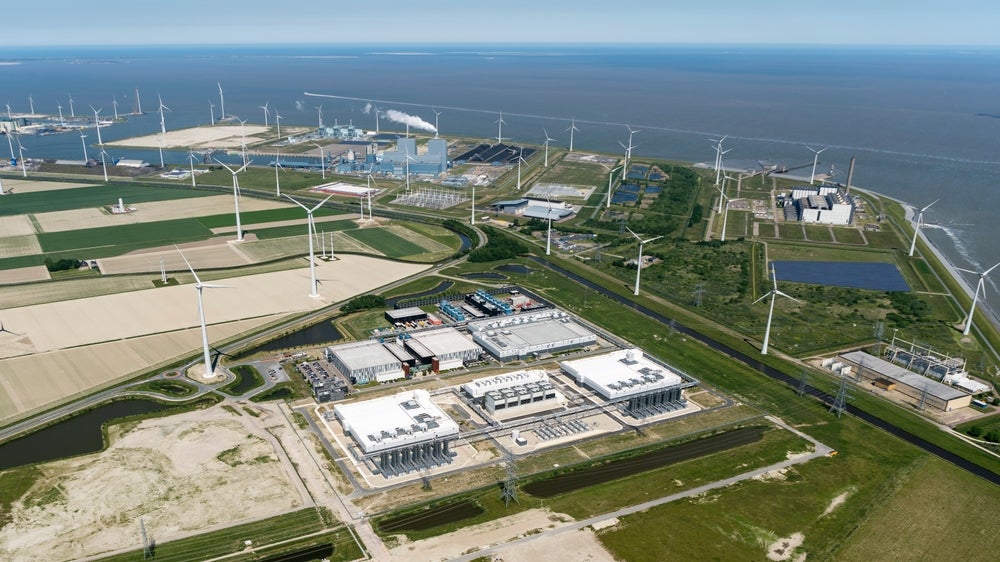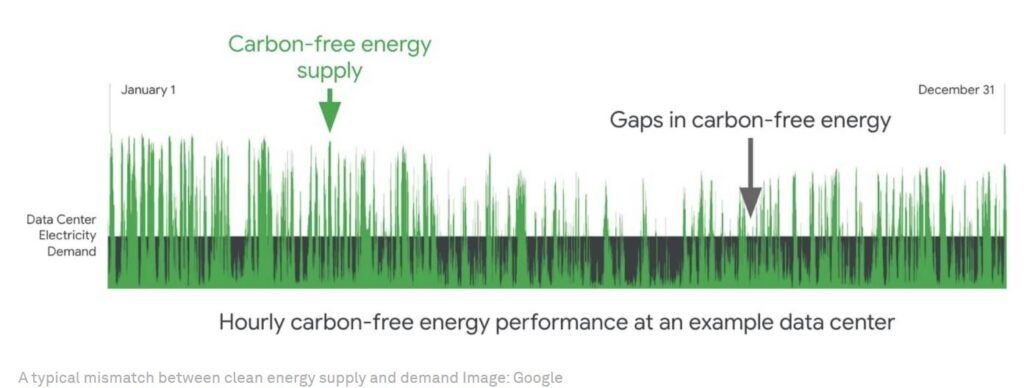On 20 October, a pioneering alliance was forged in the name of climate action that would have flown under the radar for all but the nerdiest of energy wonks. C40 Cities, a global network of mayors, joined forces with Google to launch the 24/7 Carbon-Free Energy for Cities programme, an initiative aimed at supporting cities around the world implement the concept of 24/7 carbon-free electricity to accelerate the decarbonisation of electricity grids.
In this context, pursuing 24/7 carbon-free energy means aiming to meet every kilowatt-hour of electricity consumption with carbon-free sources – for example wind, solar or nuclear power – every hour of every day, every day of the year. London, Copenhagen and Paris will be the pilot cities for the programme, and Google will offer each its expertise based on the company’s experience in pursuing its own 24/7 carbon-free energy goal, including data and critical policy and market reforms.

Discover B2B Marketing That Performs
Combine business intelligence and editorial excellence to reach engaged professionals across 36 leading media platforms.

“[The] partnership will enable us to advance our energy procurement and use clean energy at peak hours,” said Sophie Hæstorp Andersen, Lord Mayor of Copenhagen, in a statement. “Ultimately, this will enable running our municipal operations on clean energy sources 24 hours a day, 7 days a week – setting a path for others to follow.”
Indeed, 24/7 carbon-free energy is fast becoming the de rigueur decarbonisation strategy for the world’s most climate-conscious cities and companies. It is the new gold standard – but should it be?
“Helping the renewable market grow”
Typically, when a company or city claims to run on 100% clean energy, it has totalled up its electricity consumption at the end of the year and bought an equal amount of clean electricity to cover it. However, this does not mean every electron it has consumed is clean.
“When you are [part of the] RE100 [businesses committed to 100% renewable electricity], you are not carbon free, because the financial and energy instruments they use don’t represent the physical reality of the grid,” says Giacomo Bravaccini, marketing manager at Flexidao, a software provider for 24/7 electricity and carbon tracking. “A company that consumes energy just at night and buys solar certificates can still claim to be 100% renewable. There is no physical correlation between the electricity they buy in the financial world and the electricity they consume [in the real world].”

US Tariffs are shifting - will you react or anticipate?
Don’t let policy changes catch you off guard. Stay proactive with real-time data and expert analysis.
By GlobalDataBravaccini points to recent studies from the universities of Berlin (supported by Google) and Princeton stating that, on average, when an organisation is 100% annually matched, it is only 55–70% hourly matched with carbon-free energy.
To understand this, we must look back at the history of the ‘renewable energy certificate’ – RECs in the US, REGOs (Renewable Energy Guarantees of Origin) in the UK and GOs (Guarantees of Origin) in the EU. Originally, RECs were a mechanism used by utilities to comply with statutory renewable energy requirements. A wind or solar farm would receive a REC for every megawatt-hour of renewable electricity it produced, which would have to be approved by regulators.
Then the voluntary RECs market came along, and the certificates could be “unbundled” and traded numerous times before being “retired” by a final owner to claim the environmental benefits. It was thought this second income stream would encourage the development of new renewable projects, but in the subsequent years wind and solar became incredibly cheap, and the cost of an unbundled REC fell from $5 in 2008 to $1 in 2010, where it has remained ever since. Although the unbundled RECs market weathered this, it became apparent it was no longer catalysing new renewable energy installations.
The corporate sector began moving toward long-term power purchase agreements (PPAs), where the buyer would acquire both the energy and the bundled REC from a prospective project for 10–25 years. Although many organisations still buy unbundled RECs, this switch by the corporate big dogs successfully encouraged renewables developers to start building new-generation projects again.
However, there remains a problem with RECs, bundled and unbundled alike: they tell the buyer how much renewable energy was generated but not when it was generated – and for energy sources dependent on the weather, such as wind and solar power, timing matters.
If people keep buying the cheapest solar and wind RECs, the grid will eventually become imbalanced. During hours of peak wind and sun, there will be excess supply, but when it is cloudy or dark there is not enough to go round, and buyers have to turn to natural gas peaker plants.
Part of the allure of the 24/7 carbon-free energy movement is that it will spotlight and bring forward the investment required for technologies that can fill in for the variability of wind and solar, including demand side management, energy storage and clean firm generation (carbon-free energy sources that can be turned on when needed and run for days or weeks, such as nuclear, hydro or geothermal).
“24/7 carbon-free energy will really help the development of these technologies, which will eventually make the price drop,” says Bravaccini. “Basically, it is helping the [renewable] market grow.”

24/7 carbon-free energy leaders
Momentum in the 24/7 carbon-free energy movement has been growing since the launch of a UN Energy Compact in September 2021. Cities including Des Moines, Iowa, and Ithaca, New York, as well as countries such as Iceland and Scotland, have committed to 24/7 carbon-free energy targets. The Biden administration set a goal for the US federal government to consume 100% carbon-free electricity by 2030, with 50% of that matched hourly.
At the institutional level, California community choice aggregator Peninsula Clean Energy has pledged to 24/7 carbon-free energy by 2025; Google, Microsoft and the Sacramento Municipal Utility District by 2030; and the Los Angeles Department of Water and Power by 2035. In Europe, there are more than 70 members of the European 24/7 Hub, an industry association aiming to accelerate the transition to a 24/7 carbon-free energy power system.
[Keep up with Energy Monitor: Subscribe to our weekly newsletter]
Google has been a pioneer of the movement, releasing an influential white paper in 2018 called 'The Internet is 24x7. Carbon-free energy should be too'. Last year, the tech giant was 66% matched on an hourly basis with carbon-free energy, signing 7GW of clean energy contracts to support that. On 1 November 2022, Google agreed a solar PPA with SB Energy Global, tied to 942MW of generating capacity, for the search engine to match the electricity consumption of its Midlothian data centre in Texas.
“We want to bring the industry along with us to provide new solutions to the market so that all customers can be serviced with carbon-free energy solutions,” Amanda Peterson Corio, Google’s global head of data centre energy, recently told the RE-Source 2022 conference in Amsterdam. “We are also working on the policy and market development side. There is still a lot of work to do.”
If buyers want to fill their hourly shortfalls, they will need access to time-stamped carbon-free electricity – essentially hourly RECs. To this end, Google is working with non-profit M-RETS to develop Time-based Energy Attribute Certificates (T-EACs). A monthly REC would be replaced with 744 T-EACs, each recording exactly how much carbon-free electricity was generated in every hour of the month.

T-EACs are now being piloted in the US Midwest, but to be scaled up globally, the certificates will need to be standardised and integrated into existing tracking systems and carbon accounting programmes, and grid operators will need to enable customers to access and understand their hourly energy data. “This is a big task, which amounts to rebuilding a rather large plane [REC markets] while it is in flight,” wrote energy commentator David Roberts in a blog post last year. “But the information necessary to do it exists.”
Perhaps even more challenging is what comes next: integrating carbon information and accounting into T-EACs to show exactly how much carbon was avoided by the carbon-free energy. This will allow buyers to prioritise the T-EACs likely to negate the most emissions, as well as more accurately track their scope 2 emissions, which thus far has been done imperfectly using RECs.
There are real technical difficulties in measuring avoided carbon, but companies such as electricityMap, WattTime and Kevala are trying to provide hourly emissions data. Similarly, organisations like EnergyTag and LF Energy are working on standards and common definitions.
“There are challenges around the data, both in understanding demand profiles and also what the grid mix looks like,” says Nate Hausman, manager of clean energy markets at the World Resources Institute’s US Energy Program. “Some cities don't even have the advanced metering infrastructure to understand their loads, and there is also a cost premium to all this for the buyers: it is obviously a lot less expensive to just buy the cheapest RECs.”
Wind in the sails
In an ideal world, 24/7 carbon-free energy is a goal that would be achieved through government policy such as a clean energy standard for a net-zero power sector by 2030 or 2035. The private sector is essentially bringing forward a problem decarbonising grids will eventually have to overcome.
There are, however, questions over whether the 24/7 trend constitutes the best climate strategy. Some believe companies should concentrate on cutting the most carbon possible as fast as possible (often referred to as 'emissionality'), and that hourly T-EACs are just a return to unbundled RECs, with the same risk of accounting trickery substituting for actual emissions cuts.
“Before they get too excited about advanced nuclear and CCS, everyone needs to make sure that wind and solar are growing fast enough to mostly decarbonise the grid by 2030,” writes Roberts. “I worry that 24/7 procurement is part of this trend: turning our eyes to the 2040–50 horizon, the last 10–20% of grid decarbonisation, before we have the first 80% locked in.”
However, rather than pitting one against the other, 24/7 carbon-free energy and emissionality could complement one another, says Hausman. Companies could do one or the other, or a combination, depending on what they are trying to achieve.
The Berlin and Princeton studies do provide some empirical evidence that 24/7 carbon-free energy is a more effective approach than 100% annual matching. The studies found that, despite a slight cost premium of varying degrees, 24/7 carbon-free energy procurement leads to lower emissions for both the buyer and the energy system and reduces the need for flexibility in the rest of the system. It also drives early deployment of clean firm generation and long-duration energy storage, and better matches participating demand during periods of limited supply, thereby driving significantly more retirement of natural gas plants than 100% annual matching.
“I think you will see in the next five years that [24/7 carbon-free energy] is really going to scale,” says Hausman. “There is a slew of actors that are moving this forward at a rapid pace. There is a lot of wind in the sails; it is a very exciting time.”





